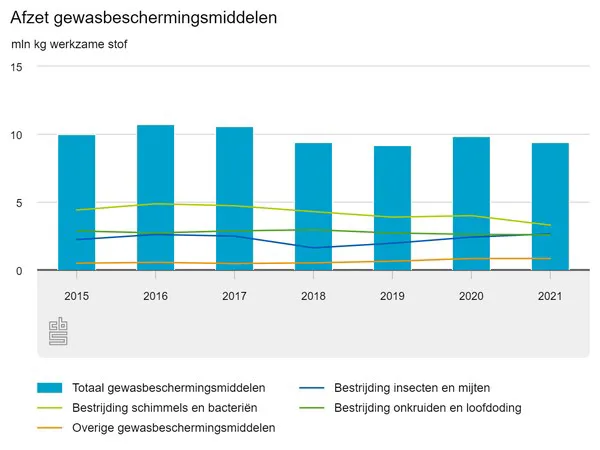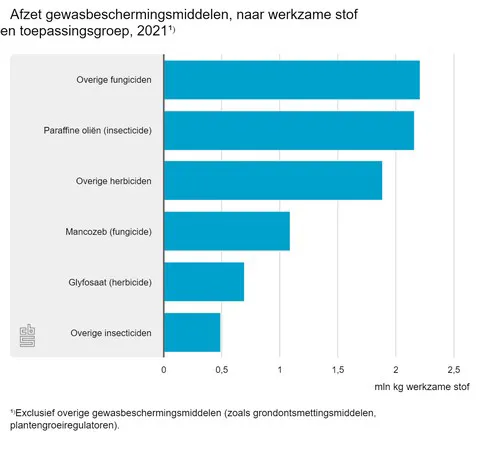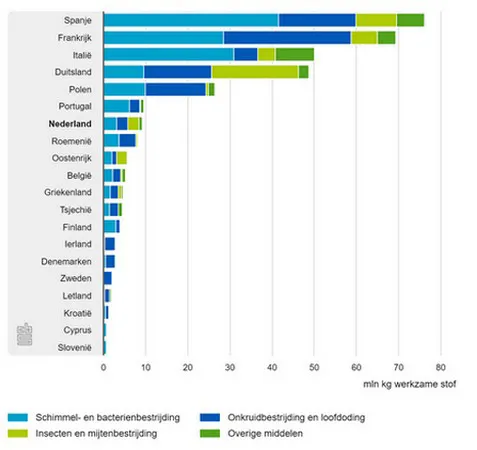In 2021, 9,4 million kilograms of crop protection products were sold in the Netherlands. That is five percent less than in 2020 when sales increased to nearly ten million kilograms of active ingredients. There were especially fewer fungicides sold in 2021. Compared to other EU countries, quite a lot of crop protection products are sold in the Netherlands in relation to how much agricultural land it has. That is according to CBS's latest crop protection product sales figures.
The agricultural sector and individuals use crop protection products to prevent or control diseases, pests, or weeds. Some agents are based on chemically active substances, others on microbiologically active substances (viruses, bacteria). Other substances like kerosene oil are considered green crop protection.
In 2021, most (35%) of the crop protection products sold were used to control fungi and bacteria, 28% to prevent weeds and haulm, and another 28% for insect and mite control. Before 2017, crop protection product sales hovered around 11 million kilos. That was the last time the ten million kg mark was exceeded. After that, sales declined for a few years, but in 2020, they rose again to almost ten million kilograms.

Source: CBS
Far fewer fungicides sold
In 2021, fungicide sales fell by more than 17% to 3.3 million kilograms of active ingredient. Sales of weed and haulm prevention substances also declined by more than one percent. Insect and mite control agent sales increased by ten percent to 2.7 million kg. More (900,000 kilograms) of other substances were sold too.
Mancozeb and glyphosate sales down
Compared to 2020, in 2021, Mancozeb - a fungicide - sales plummeted by almost 49% to 1.1 million kilograms of active ingredient. From June 1 of that year, the EU banned the use of Mancozeb for crop protection. Other fungicide sales increased by 18% to 2.2 million kilos.
The herbicide (weed killer) glyphosate sales fell by more than nine percent to 700,000kg of active ingredient in 2021. Sales of other herbicides rose by nearly two percent to 1.9 million kilograms of active ingredients. In 2021, seven percent more - 2.2 million kg of active ingredient - kerosene oils (for controlling plant viruses via aphids) were sold. Other insecticide sales increased by 23% (to 500,000 kilos).

CBS graph
At 2.6%, pesticide sales in the Netherlands are quite high
In 2021, crop protection products sold in the Netherlands (9.4 million kg of active ingredient) constituted 2.6% of total European sales (355 million kilos of active ingredient). The Dutch agricultural area covered about one percent of that year's total European agricultural area. Thus, relatively large amounts of plant protection products are sold in the Netherlands.
From 2014 to 2016, about 370 million kilograms of crop protection products were sold per year in the European Union (EU-27). Since then, that fell to 333 million kilograms in 2019 but increased again to 346 million kilograms in 2020. In 2021, it climbed a further three percent to 355 million kilograms.
Of the countries that made their data public in 2021, Spain sold the most plant protection product in the EU, with over 21%. France (20%), Italy, and Germany (both 14%) followed. These four countries make up 57% of total EU sales. So, since these countries took up slightly more than half (51%) of Europe's agricultural land, they sold rather sizeable quantities of crop protection products.

This CBS chart shows crop protection sales in the EU-27 in 2021.
Source: CBS
